Home > Historical Heritage Tours > Kingdom of the Dragon and Lion > < Day 6 ….. Day 8 >
We begin the day with a visit to Goodrich Castle which occupies a very picturesque position near the River Wye south of the town of Ross On Wye. The castle was first built in the 13th century by the English thegn (Anglo Saxon Lord) Godric from whom it was named. 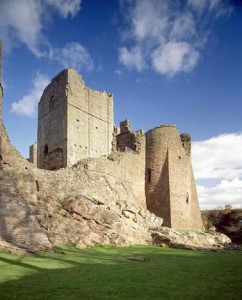 A generation later the splendidly preserved square keep which still forms its core was added, probably in the time of Richard ‘Strong bow’ de Clare, Earl of Pembroke and Lord of Goodrich 1148-76. Goodrich Castle’s visitor centre features a small exhibition which explores life at the castle from it’s origins in the late 11th century until it’s dramatic fall in 1646 during the English Civil War, when it was bombarded by parliamentary forces by a large canon nicknamed “Roaring Meg” which is on display.
A generation later the splendidly preserved square keep which still forms its core was added, probably in the time of Richard ‘Strong bow’ de Clare, Earl of Pembroke and Lord of Goodrich 1148-76. Goodrich Castle’s visitor centre features a small exhibition which explores life at the castle from it’s origins in the late 11th century until it’s dramatic fall in 1646 during the English Civil War, when it was bombarded by parliamentary forces by a large canon nicknamed “Roaring Meg” which is on display.
From Goodrich the tour follows the course of the River Wye as it slowly meanders through the thickly wooded hills of the Forest Of Dean to the Bristol Channel. This scenery is recognised as being some of the finest landscape scenery in Britain and as such classified as being an Area of Outstanding Natural Beauty (AONB). The Wye Valley witnessed the birth of British tourism in the eighteenth century and the earliest known appreciation of the area’s spectacular beauty can be dated to the beginning of the century, when John Kyrle (a barrister and member of parliament) developed the ‘Prospect’ at Ross-on-Wye, a public garden on the hilltop just above Ross town centre where a viewpoint and walkways were set out and a public fountain provided clean water for town residents. The “Prospect” was a great attraction for those seeking fine views of the River Wye and celebrated in verse by Alexander Pope. In 1745, the area became more widely known following publication of works by the poet Thomas Gray, and, in particular “Observations on the River Wye” by the Reverend William Gilpin, published in 1782, the first illustrated tour guide to be published in Britain, and providing travellers with a guidebook to locate and enjoy the most “Picturesque” aspects of the River Wye. During our day within the Wye Valley we will follow in the footsteps of many famous poets, writers and artists such as Coleridge, Thackeray, Turner. and Wordsworth who made an artistic pilgrimage along the Wye to see sights such as Goodrich Castle, Tintern Abbey and Symonds Yat rock to base their literally and artistic works. In July 1798, William Wordsworth after his second visit to the Wye Valley wrote “Tintern Abbey”, the words of which are the perfect emobodiement of the Romantics vision of the British landscape.
the eighteenth century and the earliest known appreciation of the area’s spectacular beauty can be dated to the beginning of the century, when John Kyrle (a barrister and member of parliament) developed the ‘Prospect’ at Ross-on-Wye, a public garden on the hilltop just above Ross town centre where a viewpoint and walkways were set out and a public fountain provided clean water for town residents. The “Prospect” was a great attraction for those seeking fine views of the River Wye and celebrated in verse by Alexander Pope. In 1745, the area became more widely known following publication of works by the poet Thomas Gray, and, in particular “Observations on the River Wye” by the Reverend William Gilpin, published in 1782, the first illustrated tour guide to be published in Britain, and providing travellers with a guidebook to locate and enjoy the most “Picturesque” aspects of the River Wye. During our day within the Wye Valley we will follow in the footsteps of many famous poets, writers and artists such as Coleridge, Thackeray, Turner. and Wordsworth who made an artistic pilgrimage along the Wye to see sights such as Goodrich Castle, Tintern Abbey and Symonds Yat rock to base their literally and artistic works. In July 1798, William Wordsworth after his second visit to the Wye Valley wrote “Tintern Abbey”, the words of which are the perfect emobodiement of the Romantics vision of the British landscape.
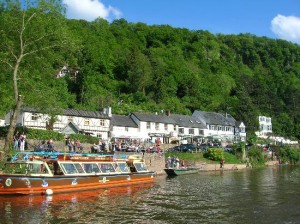 A short distance away from Goodrich Castle is the famous vantage point of Symonds Yat Rock, which has a spectacular view of the River Wye as it winds along a thickly wooded valley. An alternative perspective can be had of the Wye during our boat trip at Symonds Yat when we will take a sedate cruise lasting 40mins through this very picturesque part of the valley. After the river cruise we will travel across the border to the ancient Welsh town of Monmouth situated at a confluence of the River Wye and the River Monmow. The town has an exceptionally long history stretching as far back as the Roman occupation of Britain and was an important stronghold throughout the Medieval period. Like many Border castles, that of Monmouth has been substantially degraded owing to conflict, stone plunder and weathering to become a Romantic ruin to inspire the imagination. But we will learn how Monmouth Castle, which was established by the Breton William Fitz Osbern in the late 11th century, had a significant role to play in history including being the birthplace of King Henry V of England, who’s great victory at Agincourt against the French was immortalised by William Shakespeare’s Play “Henry V’ and many parts of Monmouth, including the town’s main square, are named after this battle.
A short distance away from Goodrich Castle is the famous vantage point of Symonds Yat Rock, which has a spectacular view of the River Wye as it winds along a thickly wooded valley. An alternative perspective can be had of the Wye during our boat trip at Symonds Yat when we will take a sedate cruise lasting 40mins through this very picturesque part of the valley. After the river cruise we will travel across the border to the ancient Welsh town of Monmouth situated at a confluence of the River Wye and the River Monmow. The town has an exceptionally long history stretching as far back as the Roman occupation of Britain and was an important stronghold throughout the Medieval period. Like many Border castles, that of Monmouth has been substantially degraded owing to conflict, stone plunder and weathering to become a Romantic ruin to inspire the imagination. But we will learn how Monmouth Castle, which was established by the Breton William Fitz Osbern in the late 11th century, had a significant role to play in history including being the birthplace of King Henry V of England, who’s great victory at Agincourt against the French was immortalised by William Shakespeare’s Play “Henry V’ and many parts of Monmouth, including the town’s main square, are named after this battle. 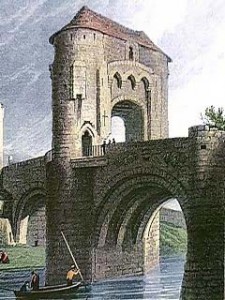
 Although little today remains of the castle the town has retained its original Medieval bridge gatehouse constructed over the River Monmow in the late 13th century and which has become symbolic of this ancient Border town.
Although little today remains of the castle the town has retained its original Medieval bridge gatehouse constructed over the River Monmow in the late 13th century and which has become symbolic of this ancient Border town.
After lunch a chance to explore Monmouth we will travel to one of the most famous landscape settings in the British Isles at Tintern Abbey. The Cistercian abbey at Tintern, is one of the greatest monastic ruins in Wales, originally founded in 1131 by Walter de Clare and added to and updated in every century until its dissolution in 1536 by King Henry VIII. The abbey buildings were arranged in a standard Cistercian plan, except that the cloisters and all ancillary buildings were to the north of the church rather than to the south, which was more usual. The remains seen today are an amalgam of several phases of building spanning over 400 years. The shell of the abbey stands open to the skies almost to its full height, an outstanding example of the elaborate “decorated” style of Gothic architecture. You can still appreciate its vast windows with their delicate tracery, and the wealth of decorative detail displayed in the walls, doorways and soaring archways.
 The majestic ruins of Tintern and it’s beautiful location have inspired generations of writers, poets and artists. The great English poet William Wordsworth in his book “Tintern Abbey” writes from the perspective of being a man returning to this place and remembering the time when he came as a boy, 5 years before. Wordsworth writes of all the youthful enthusism and wonder he had in the presence of being in such a beautiful natural place and how experiences of being there had been preserved in his memories and emotions. He also reflects at this earlier times with a degree of sorrow at how the time has past and how he has aged and no longer sees or experiences the World the same way.
The majestic ruins of Tintern and it’s beautiful location have inspired generations of writers, poets and artists. The great English poet William Wordsworth in his book “Tintern Abbey” writes from the perspective of being a man returning to this place and remembering the time when he came as a boy, 5 years before. Wordsworth writes of all the youthful enthusism and wonder he had in the presence of being in such a beautiful natural place and how experiences of being there had been preserved in his memories and emotions. He also reflects at this earlier times with a degree of sorrow at how the time has past and how he has aged and no longer sees or experiences the World the same way.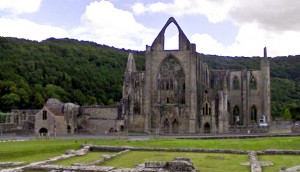 However during his self analysis triggered by returning to Tintern Abbey, Wordsworth comes to the realisation that something has also changed for the better in him which enables a greater depth of feeling and spiritual connection with nature that his maturity of years has fostered. The poem is written to Wordsworth’s sister and is deeply expressive of his thoughts and feelings about this very special place on the banks of the River Wye at Tintern, which we are sure will touch you every bit as much..
However during his self analysis triggered by returning to Tintern Abbey, Wordsworth comes to the realisation that something has also changed for the better in him which enables a greater depth of feeling and spiritual connection with nature that his maturity of years has fostered. The poem is written to Wordsworth’s sister and is deeply expressive of his thoughts and feelings about this very special place on the banks of the River Wye at Tintern, which we are sure will touch you every bit as much..
http://www.youtube.com/watch?v=q8-5kHj5_4c
From Tintern we travel further down the Wye valley to Chepstow where it enters the wide estuary of the River Severn. Our last visit to the castles along the Welsh border is to Chepstow Castle which is situated on a clifftop position on the banks of the river Wye and is the oldest stone castle in Britain. The castle was first established by William Fitz Osbern, a loyal supporter and steward of William the Conqueror and was one of the first to be built by the Norman lords to secure the borderlands with Wales. He died in 1071 and, following his son’s plotting against the king, the castle passed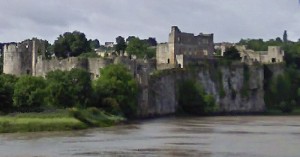 to the Crown in 1075. At the end of the 12th century, Chepstow passed by marriage to William Marshall, Earl of Pembroke who undertook additional modifications to its structure and subsequently his sons did likewise and owing to its close proximity to the River the castle gradually evolved into a linear form instead of having a the usual concentric layout. Roger Bigod, earl of Norfolk, later acquired the castle in the late 13th century and Chepstow remained a stronghold of the Marcher Lords throughout the Middle Ages.
to the Crown in 1075. At the end of the 12th century, Chepstow passed by marriage to William Marshall, Earl of Pembroke who undertook additional modifications to its structure and subsequently his sons did likewise and owing to its close proximity to the River the castle gradually evolved into a linear form instead of having a the usual concentric layout. Roger Bigod, earl of Norfolk, later acquired the castle in the late 13th century and Chepstow remained a stronghold of the Marcher Lords throughout the Middle Ages.
Day 7 Highlights:
- Goodrich Castle
- Forest Of Dean & Wye Valley
- Symonds Yat Rock
- Boat trip at Symonds Yat
- Monmouth
- Momouth Castle
- Medieval bridge gatehouse
- Tintern Abbey
- Chepstow Castle




